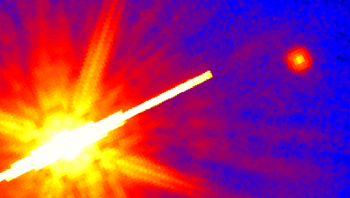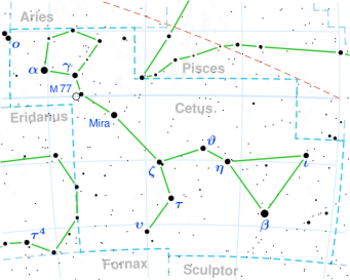Astronomy:Gliese 105
Coordinates: ![]() 02h 36m 04.89466s, +06° 53′ 12.7466″
02h 36m 04.89466s, +06° 53′ 12.7466″
| Observation data {{#ifeq:J2000|J2000.0 (ICRS)|Epoch J2000.0 Equinox J2000.0 (ICRS)| Epoch J2000 [[Astronomy:Equinox (celestial coordinates)|Equinox J2000}} | |
|---|---|
| Constellation | Cetus |
| Gliese 105 A | |
| Right ascension | 02h 36m 04.89466s[1] |
| Declination | +06° 53′ 12.7466″[1] |
| Apparent magnitude (V) | 5.83[2] |
| Gliese 105 B | |
| Right ascension | 02h 36m 15.357s[3] |
| Declination | +06° 52′ 19.14″[3] |
| Apparent magnitude (V) | 11.670[4] |
| Gliese 105 C | |
| Right ascension | 02h 36m 04.66s[5] |
| Declination | +06° 53′ 14.8″[5] |
| Apparent magnitude (V) | 16.77[5] |
| Characteristics | |
| Gliese 105 AC | |
| Spectral type | K3 V[2] + M7 V[6] |
| U−B color index | +0.800[7] |
| B−V color index | +0.972[7] |
| Gliese 105 B | |
| Spectral type | M4.0 V |
| U−B color index | +1.10[8] |
| B−V color index | +1.61[8] |
| Variable type | BY Dra |
| Astrometry | |
| Gliese 105 A | |
| Radial velocity (Rv) | 25.8 ± 0.1[9] km/s |
| Proper motion (μ) | RA: 1778.585±0.430[10] mas/yr Dec.: 1477.306±0.248[10] mas/yr |
| Parallax (π) | 138.3400 ± 0.3177[10] mas |
| Distance | 23.58 ± 0.05 ly (7.23 ± 0.02 pc) |
| Absolute magnitude (MV) | 6.50[11] |
| Gliese 105 B | |
| Proper motion (μ) | RA: 1801.671±0.043[12] mas/yr Dec.: 1450.487±0.038[12] mas/yr |
| Parallax (π) | 138.4371 ± 0.0420[12] mas |
| Distance | 23.560 ± 0.007 ly (7.223 ± 0.002 pc) |
| Orbit[13] | |
| Period (P) | 76.107 ± 1.820 yr |
| Semi-major axis (a) | 17.0 ± 0.7 au |
| Eccentricity (e) | 0.641 ± 0.004 |
| Inclination (i) | 45.5 ± 2.8° |
| Longitude of the node (Ω) | 122.5 ± 3.4° |
| Periastron epoch (T) | JD 2430414 ± 669 |
| Argument of periapsis (ω) (primary) | 133.4 ± 0.6° |
| Semi-amplitude (K1) (primary) | 711.7 ± 2.2 km/s |
| Details | |
| Gliese 105 A | |
| Mass | 0.70 ± 0.10[14] M☉ |
| Radius | 0.650 ± 0.053[2] R☉ |
| Luminosity (bolometric) | 0.26[14] L☉ |
| Surface gravity (log g) | 4.40 ± 0.24[15] cgs |
| Temperature | 4777 ± 91[15] K |
| Metallicity [Fe/H] | −0.03 ± 0.09[15] dex |
| Gliese 105 B | |
| Mass | 0.246 ± 0.025[4] M☉ |
| Radius | 0.278 ± 0.010[4] R☉ |
| Temperature | 3284 ± 60[4] K |
| Other designations | |
268 G. Cet, Gl 105, CCDM J02361+0653, BD+06° 398 | |
| Gliese 105 AC: HR 753, HD 16160, LHS 15, LTT 10858, SAO 110636, FK5 1073, G 73-70, G 76-11, LFT 217, HIP 12114 | |
| Gliese 105 B: BX Cet, LHS 16, LTT 10859, G 73-71, G 76-12, LFT 217 | |
| Database references | |
| SIMBAD | Gl 105 |
| Gl 105 A | |
| Gl 105 B | |
| Gl 105 C | |
Location of Gliese 105 in the constellation Cetus | |
Gliese 105 (also known as 268 G. Ceti) is a triple star system in the constellation of Cetus. It is located relatively near the Sun at a distance of 23.6 light-years (7.2 parsecs).[10][12] Despite this, even the brightest component is barely visible with the unaided eye (see Bortle scale). No planets have yet been detected around any of the stars in this system.
This is a triple system with three stars that are all less massive than the Sun. The brightest component is designated HD 16160, and is known as Gliese 105 A. It is a K-type main-sequence star,[2] about 70% the mass of the Sun.[14] This star is unusual because its eruptions appear to not conform to the Waldmeier effect—i.e., the strongest eruptions of HD 16160 are not the ones characterized by the fast eruption onset.[16]
A nearby star has a similar proper motion to Gliese 105 A, so it is assumed to be physically associated with the primary, and is known as Gliese 105 B. The two have an estimated separation of 1,200 astronomical units (au). It is a BY Draconis variable star whose brightness varies between 11.64 and 11.68 magnitudes; for that reason it has been given the designation BX Ceti.[17]
A third companion, known as Gliese 105 C, lies much closer to A, currently at a distance of approximately 24 au.[6] The pair A-C have an estimated orbital period of about 70 years.[13] While detected directly, Gliese 105 C has also been observed to perturb Gliese 105 A from its usual position;[6] from that, its orbit is estimated to have a high eccentricity of around 0.64 and a semimajor axis of 17 au.[13] Gliese 105 C is an extremely faint red dwarf.[6] It is roughly 8 to 9 percent the mass of the Sun, and it is about 20,000 times fainter than its parent star in visible light—at a distance of 1 au (the distance from the Earth to the Sun) it would only be four times brighter than the full moon.[18]
References
- ↑ Jump up to: 1.0 1.1 van Leeuwen, F. (2007). "Validation of the new Hipparcos reduction". Astronomy and Astrophysics 474 (2): 653–664. doi:10.1051/0004-6361:20078357. Bibcode: 2007A&A...474..653V. http://www.aanda.org/index.php?option=com_article&access=bibcode&Itemid=129&bibcode=2007A%2526A...474..653VFUL. Vizier catalog entry
- ↑ Jump up to: 2.0 2.1 2.2 2.3 van Belle, Gerard T.; von Braun, Kaspar (2009). "Directly Determined Linear Radii and Effective Temperatures of Exoplanet Host Stars". The Astrophysical Journal 694 (2): 1085–1098. doi:10.1088/0004-637X/694/2/1085. Bibcode: 2009ApJ...694.1085V.
- ↑ Jump up to: 3.0 3.1 Cutri, Roc M.; Skrutskie, Michael F.; Van Dyk, Schuyler D.; Beichman, Charles A.; Carpenter, John M.; Chester, Thomas; Cambresy, Laurent; Evans, Tracey E. et al. (2003). "VizieR Online Data Catalog: 2MASS All-Sky Catalog of Point Sources (Cutri+ 2003)". CDS/ADC Collection of Electronic Catalogues 2246: II/246. Bibcode: 2003yCat.2246....0C. http://vizier.u-strasbg.fr/viz-bin/VizieR?-source=II/246.
- ↑ Jump up to: 4.0 4.1 4.2 4.3 Mann, Andrew W.; Feiden, Gregory A.; Gaidos, Eric; Boyajian, Tabetha; von Braun, Kaspar (2015). "How to Constrain Your M Dwarf: Measuring Effective Temperature, Bolometric Luminosity, Mass, and Radius". The Astrophysical Journal 804 (1): 38. doi:10.1088/0004-637X/804/1/64. Bibcode: 2015ApJ...804...64M.
- ↑ Jump up to: 5.0 5.1 5.2 "GJ 105 C". SIMBAD. Centre de données astronomiques de Strasbourg. http://simbad.u-strasbg.fr/simbad/sim-basic?Ident=GJ+105+C.
- ↑ Jump up to: 6.0 6.1 6.2 6.3 Golimowski, David A. et al. (2000). "The Very Low Mass Component of the Gliese 105 System". The Astronomical Journal 120 (4): 2082–2088. doi:10.1086/301567. Bibcode: 2000AJ....120.2082G.
- ↑ Jump up to: 7.0 7.1 González-Hernández, J. I.; Bonifacio, P. (2009). "A new implementation of the infrared flux method using the 2MASS catalogue". Astronomy & Astrophysics 497 (2): 497. doi:10.1051/0004-6361/200810904. Bibcode: 2009A&A...497..497G.
- ↑ Jump up to: 8.0 8.1 Mermilliod, J.-C. (1986). "Compilation of Eggen's UBV data, transformed to UBV (unpublished)". Catalogue of Eggen's UBV Data. Bibcode: 1986EgUBV........0M.
- ↑ Gontcharov, G. A. (2006). "Pulkovo Compilation of Radial Velocities for 35 495 Hipparcos stars in a common system". Astronomy Letters 32 (11): 759–771. doi:10.1134/S1063773706110065. Bibcode: 2006AstL...32..759G.
- ↑ Jump up to: 10.0 10.1 10.2 10.3 Brown, A. G. A. (2021). "Gaia Early Data Release 3: Summary of the contents and survey properties". Astronomy & Astrophysics 649: A1. doi:10.1051/0004-6361/202039657. Bibcode: 2021A&A...649A...1G. Gaia EDR3 record for this source at VizieR.
- ↑ Cardini, D. (January 2005), "Mg II chromospheric radiative loss rates in cool active and quiet stars", Astronomy and Astrophysics 430: 303–311, doi:10.1051/0004-6361:20041440, Bibcode: 2005A&A...430..303C.
- ↑ Jump up to: 12.0 12.1 12.2 12.3 Brown, A. G. A. (2021). "Gaia Early Data Release 3: Summary of the contents and survey properties". Astronomy & Astrophysics 649: A1. doi:10.1051/0004-6361/202039657. Bibcode: 2021A&A...649A...1G. Gaia EDR3 record for this source at VizieR.
- ↑ Jump up to: 13.0 13.1 13.2 Feng, Fabo; Butler, R Paul; Jones, Hugh R A.; Phillips, Mark W.; Vogt, Steven S.; Oppenheimer, Rebecca; Holden, Bradford; Burt, Jennifer et al. (2021). "Optimized modelling of Gaia–Hipparcos astrometry for the detection of the smallest cold Jupiter and confirmation of seven low-mass companions". Monthly Notices of the Royal Astronomical Society 507 (2): 2856–2868. doi:10.1093/mnras/stab2225. Bibcode: 2021MNRAS.507.2856F.
- ↑ Jump up to: 14.0 14.1 14.2 Ghezzi, L.; Cunha, K.; Smith, V. V.; De Araújo, F. X.; Schuler, S. C.; de la Reza, R. (2010). "Stellar Parameters and Metallicities of Stars Hosting Jovian and Neptunian Mass Planets: A Possible Dependence of Planetary Mass on Metallicity". The Astrophysical Journal 720 (2): 1290–1302. doi:10.1088/0004-637X/720/2/1290. Bibcode: 2010ApJ...720.1290G.
- ↑ Jump up to: 15.0 15.1 15.2 Paletou, F.; Böhm, T.; Watson, V.; Trouilhet, J.-F. (2015). "Inversion of stellar fundamental parameters from ESPaDOnS and Narval high-resolution spectra". Astronomy & Astrophysics 573: A67. doi:10.1051/0004-6361/201424741. Bibcode: 2015A&A...573A..67P.
- ↑ Garg, Suyog; Karak, Bidya Binay; Egeland, Ricky; Soon, Willie; Baliunas, Sallie (2019), "Waldmeier Effect in Stellar Cycles", The Astrophysical Journal 886 (2): 132, doi:10.3847/1538-4357/ab4a17, Bibcode: 2019ApJ...886..132G
- ↑ Samus, N. N. et al. (2009). "VizieR Online Data Catalog: General Catalogue of Variable Stars (Samus+ 2007-2013)". VizieR On-line Data Catalog: B/GCVS. Originally Published in: 2009yCat....102025S 1. Bibcode: 2009yCat....102025S.
- ↑ "A Really Cool Star: The Dim, Low-Temperature GL 105C". HubbleSite. 14 September 1995. http://hubblesite.org/image/329/news_release/1995-33.
External links
- Gliese 105 / HR 753 ABC SolStation entry.
- Gliese 105
 |



